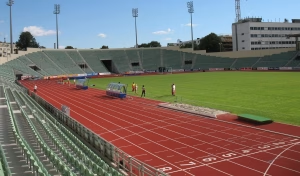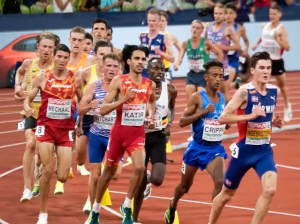Running science resarch
What is the best training for long distance running? What kinds of workouts should you emphasize? What kinds of workouts should you do less frequently? If you would like to excel in the distances between 5000 m and marathon, read on.
Let’s start by framing the question scientifically.
Is it possible to determine the elements of distance running training that most highly contribute to performance in long distance races? Put more specifically, can you examine the training of the best athletes and do a statistical analysis to figure out the kinds of training that was most highly linked to success?
All of this is possible if you have access to the athletes’ training logs and a record of their performances.
The question is answered in a 2021 scientific paper by sport science researchers from Spain and the United Kingdom. The paper by Arturo Casado and colleagues is freely available here.
Most of what I write will follow the insights of the authors, but I will also add my own opinions and will try to make it clear when I am doing so.
National and world-class athletes
The researchers analyzed training from the first seven years of systematic training. Then they calculated the strength of relationship between those training practices and competition performances.

The data includes 85 male athletes who were competitive nationally in Spain, or in the world (i.e., even better). These athletes competed in distances from 5,000 m to the marathon.
Relationship between training and performance
Because it’s sometimes hard to compare performances at different race distances they used points according to the World Athletics (formerly IAAF) scoring tables. You can use these scoring tables to assess your own performances.
Competition performances included:
- 2:03:23 marathon, a world best at the time (Wilson Kipsang, 2013)
- 58:54 half-marathon
- 26:44 road 10 km, the world record at the time (Leonard Komon, 2010)
Physiological factors
Coaches and scientists often first use a physiological approach to explaning the relationship between training and performance. We can therefore start with the key metrics that are often used to explain distance running performance. The authors mention 6 important factors:
Main physiological ingredients
- VO2 max
- Running speed at VO2 max
- Running economy
- Lactate threshold
Physiological icing on the cake
- Anaerobic capacity
- Sprinting
You can click on the links in the diagrams above. These bring you to articles where I discuss each metric more in depth.
If you build your program based on these physiological principles, you would first determine what sort of workouts best develop each of these qualities. Thus, you would have a VO2 max workout, a lactate threshold workout, etc. This is a popular and useful approach in many cases.
However, what the authors have done here is to quantity a direct connection between long-term training habits and performance.
Training factors
So, what the authors of this scientific paper did was to divide training into categories of deliberate and non-deliberate practice.
Deliberate practice is highly specific to the competition event in that it is running at race pace. Non-deliberate practice is a non-running activity, or running that is not at race pace.
Here are the possible training activities:
Deliberate practice
- tempo runs (45-70 min or 1000-5000 m)
- half marathon to marathon pace
- long-interval training (1000-2000 m)
- 5000 m to 10,000 m pace
- short-interval training (200-1000 m)
- 1500 m to 5000 m pace
- competition/time trials (5000 m to marathon)
Non-deliberate practice
- cross-training
- flexibility training
- weight training
- work with the coach
- easy runs (typically 8-40 km)
The activities were assessed for a typical week of distance running training 10 weeks before the goal race for each season. The athletes did this for 2-year intervals after they began systematic training, to capture their training 3, 5, and 7 years of experience.
For running activities, they reported the weekly distance. For non-running activities, they reported the weekly time spent.
The best training for long distance running was found to be tempo runs and short intervals, which, along with easy runs, leads to high mileage.
Results: the most important aspects of training for distance running performance
If you were going to focus on only one aspect of training, what would it be?
The most important overall variable was total volume of training.This study also provided more specific findings about the most important kinds of distance running workouts. In order, easy runs, tempo runs, and short intervals were most related to performance.
- Easy runs
- Tempo runs
- Short-interval training

Putting it all together: My recommendations
Address any deficiencies
My recommendation is to not necessarily immediately begin with base-building comprised of extensive “plain old running”. Why? You likely have several specific musculo-skeletal issues that will impede your ability to tolerate the ideal training program.
You can do everything right in the training considerations above and still have a weak link preventing you from improving further.
Remove the weakness to enhance your ability to do more training and higher quality training. In other words, by removing the weakness, you are training to train. There are lots of possiblities to consider.
These include:
- Muscle strength imbalances (left-right and front-back)
- Flexibility/mobility/range of motion limitations and imbalances
- Inadequate maximal muscle strength
- Inadequate maximal muscle power
- Poor postural habits
- Inappropriate running technique
- Poor nutritional plan and body composition
- Inadequate sleep and recovery
We can’t address any of these in this article, but I recommend that at the beginning of the season, you address one, or maybe two of the above – aspects for which you have the most to gain. Each of the above aspects requires a concerted effort to address, often requiring significant (but possible) lifestyle changes.
The good news? Making an improvement on the list above can often make you feel much better after only a few days, even if the problem has not been fully resolved. Think about if you actually get that tight muscle to release before a run, or if you add a full hour of quality sleep.
A few improvements will go a long way to enhancing your ability to handle good training.
Balance easy runs with tempo and intervals
Now we can focus on establishing a suitable base of easy running. We already know that most of your running will be at an easy pace, and a much smaller percentage will be at fast paces.
Each person has a reasonable maximal mileage for that season, based on their training history and present capabilities. I suggest the following two principles:
- Do the highest volume you can reasonably tolerate
- Ensure the proportion of fast running is appropriate
The athletes in this study tended to have about 20% of distance as tempo runs and 7-8% of distance as long- and short-interval training. That leaves 72-23% for easy runs.
| Training | 40 mi per week | 60 mi per week | 80 mi per week | 100 mi per week |
|---|---|---|---|---|
| Tempo | 8 mi | 12 mi | 16 mi | 20 mi |
| Intervals | 3 mi | 4.5 mi | 6 mi | 7.5 mi |
How to get this wrong
You can get this wrong if you fail to plan for the appropriate volume or the appropriate proportion of speedwork. Both are important, and either are overemphasized or neglected, the training program won’t be ideal.
Inappropriate pursuit of high mileage
Using a pure long-slow-distance philosophy fails to get the right balance. There is nothing wrong with this if you are content, but it won’t be the ideal training for performance, according to the results of this study.
You shouldn’t pursue high volume at all costs. This can’t actually work anyway because if you are not able to tolerate a high volume, you will get injured and need to cease or greatly reduce your training.
Inappropriate pursuit of speed work
Just because race-pace running is the most specific type of training (ie., deliberate practice), it doesn’t mean that this is all you should do.
If you want to do more race-pace running, you should seek to add some easy miles to support the higher intensity. Do your best to stick to the rough ratios provided here. Your ability to tolerate higher mileage will carry with it the ability to tolerate more speedwork in the appropriate proportion.
The numerical relationship increase is not great but most people can appreciate what it takes to add a few miles of tempo to your weekly training volume when you are already training at a fairly strenuous level if tolerated it’s easy to see how this would contribute to better performances
All other training activities support the above
How to build an appropriate base
How is it possible to accumulate and appropriately high volume of easy running distance? This is one of the most common questions runners have.
First, you should consider whether you have any significant deficiencies in the list above. An appropriate conditioning program will give you the resilience to train at hrigh volumes.
Second, you need to ensure any increases in intensity or volume are appropriately gradual so you can adapt. I have long wondered if many people conclude they have poor “genetic potential” for good training, simply because they increased their training load too quickly over the season, or over their entire running career.
There needs to be a well-reasoned increase from week-to-week and season-to-season. Weekly increases within a season should be gradual enough for adaptation, yet still allow you the number of weeks of peak training needed to accomplish your goals. From season to season, many coaches recommend an increase of peak mileage of about 5 miles. These are simple but wise guidelines.
Having a rough multi-year plan in mind can help you focus on accumulating consistent training over the weeks, months, and years of your athletic career. If training load is mismanaged and you are injured for large portions of the year without consistent training, that may hinder your ability to achieve your greatest potential.
Take heart if you have struggled with injury in the past – you can turn things around and many fabulous athletes have done the same.
The mandate for consistency does not mean you should not have planned times of mental and physical recovery. But the breaks should be planned, not forced.
Benefits of this balanced approach
Tempo runs are the most specific training for distance running performance
Tempo runs have the highest specificity because they are continuous. Often run at about half-marathon pace, the continuous nature provides not only a physiological training close to race pace, but also a psychological challenge because there are no breaks.
There is a great benefit to sustained high intensity work that seems to harden the athlete psychologically in a way that interval training does not. While interval training does allow for the accumulation of high intensity miles beyond what might be possible in a tempo run, there is a certain mental resilience that develops when you don’t have regular breaks.
Digging deep into the theory
Does this support Norwegian threshold training? That’s very popular right now.
Yes, I think it does.
The intensity that was classified as “tempo run” is simlar to that used for the Norwegian style of threshold training, which is very popular at the moment. You can see my treatment of that kind of training in this article on Ingebrigtsen threshold training.
Keep in mind that “tempo run” is distinguished from “long intervals” not by the distance of the interval but by the intensity of the effort. Both “tempo run” and “long intervals” can be run in intervals of similar length.
According the table on deliberate practice above, the cross-over is in intervals from 1000 m to 2000 m. In other words, you can run intervals of this length at a tempo pace (half marathon to marathon pace) or faster (5000 m to 10,000 m pace). The intensity makes all the difference.
Why were short intervals more important than long intervals?
The authors suggested that short interval training may be the key to distinguishing close-matched athletes. This situation often comes about during the end spurt at the end of a race.
For example, many Olympic finals in the 5000 and 10,000 m have a large pack of athletes running together the entire way. They only separate after the last lap where the winner runs 51-52 seconds and the rest run 55-56 seconds.
We might imagine that this depends on short interval training, executed well in the peaking phase of training.
Is there a better way to quantify training in a distance running program?
The authors acknowledge that the training load quantification they used was a rather simple one because it was just based on weekly distance for each kind of running workout. There are far more sophisticated methods of quantification.
Is the first 7 years of systematic training the most important time to study?
The analysis was based on the first 7 years of each athlete’s time of systematic training and may not represent the polishing that is required when already at a national or world-class level.
Starting age did not seem to be a significant tributor to performance, but I’m not going to discuss that anyway because if you are reading this article you likely have already started training seriously. So, it’s not something you can change now.
The authors of the scientific paper suggested that over the course of each athlete’s career, the importance of tempo runs increased and they suggested that there may be a progressive specialization from easy runs towards a greater emphasis on tempo. I put this in the category of training that must be developed very gradually.

Why do supplemental training at all?
You can see that the deliberate practice activities above are all running at speeds highly specific to race pace.
You might ask, then, why include non-deliberate practice activities at all? I sympathize with the question. Even though we “know” that it is important to do easy runs and lift weights, if you approach the question with only the specificity principle in mind, it can seem like you should only do specific workouts near race pace.
I won’t solve the problem here, but the typical belief is that non-deliberate practice should be considered supplemental, and allows for aspects such as base training, active recovery, and a continuous stimulus for cardiovascular conditioning and connective tissue adaptations.
It’s good to remember connective tissue adaptations because in the endurance world, aerobic fitness is king, and we often don’t think about the body’s structure, except when we’re injured. When all is well, it’s all about heart rate and oxygen.
But runners should also consider how to harden their body to be able to tolerate the physical stresses from the running motion, particularly the pounding that occurs with each footstep.
Conclusions
I think this study shows that a good distance running program can be quite simple. While many of us who cannot attain world-class levels might adopt a complex training program, this analysis shows that you can thrive on very very simple training.
This analysis also emphasizes that there is no quick way to fitness and it is highly encouraged to consider a multi-year plan, whether you are young or old; whether you are fast or slow.
Simple, patient training will lead to lots of fitness and therefore lots of fun!




